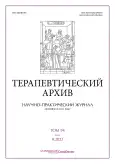The atorvastatin effects on the prevention of contrast-induced acute kidney injury during computed tomography with contrast media
- Authors: Vasin A.A.1, Mironova O.I.1, Fomin V.V.1
-
Affiliations:
- Sechenov First Moscow State Medical University (Sechenov University)
- Issue: Vol 94, No 9 (2022)
- Pages: 1057-1061
- Section: Original articles
- URL: https://journals.rcsi.science/0040-3660/article/view/112037
- DOI: https://doi.org/10.26442/0403660.2022.09.201845
- ID: 112037
Cite item
Full Text
Abstract
Aim. To assess the role of atorvastatin to the frequency of contrast-induced acute kidney injury (CI-AKI) in patients with cardiovascular diseases (CVD) undergoing computed tomography (CT) with intravenous contrast media.
Materials and methods. One hundred patients with CVD undergoing CT with with intravenous contrast media administration were included in prospective observational study (ClinicalTrials.gov ID NCT04666389). Patients were divided into 3 groups – 16 (15.8%) patients receiving atorvastatin at a dose of 80 mg 24 hours and 40 mg before the CT and 40 mg after; 33 (32.7%) patients – 40 mg before the CT and 40 mg after; 52 (51.5%) people not receiving statin therapy. The primary endpoint was CI-AKI according to KDIGO criteria: the 25% rise (or 0.5 mg/dl) of serum creatinine from baseline assessed 48–72 hours after administration of contrast media. There were 51% of men. The average age was 59.77±14.4. The most frequent cardiovascular disease was hypertension – 86%.
Results. CI-AKI was diagnosed in 4 (3.96%) patients. At the same time, it was not possible to establish statistically significant relationships (p<0.05) between risk factors and the development of CI-AKI. Statins can be a successful way to prevent this complication.
Conclusion. Cardiovascular diseases may increase the risk of CI-AKI after computed tomography with intravenous contrast media administration. Therefore, it is recommended to evaluate the serum creatinine concentration in such patients.
Full Text
##article.viewOnOriginalSite##About the authors
Andrey A. Vasin
Sechenov First Moscow State Medical University (Sechenov University)
Email: mironova_o_yu@staff.sechenov.ru
ORCID iD: 0000-0002-6261-3086
аспирант каф. факультетской терапии №1
Russian Federation, MoscowOlga Iu. Mironova
Sechenov First Moscow State Medical University (Sechenov University)
Author for correspondence.
Email: mironova_o_yu@staff.sechenov.ru
ORCID iD: 0000-0002-5820-1759
канд. мед. наук, доц. каф. факультетской терапии №1
Russian Federation, MoscowVictor V. Fomin
Sechenov First Moscow State Medical University (Sechenov University)
Email: mironova_o_yu@staff.sechenov.ru
ORCID iD: 0000-0002-2682-4417
чл.-кор. РАН, д-р мед. наук, проф., проректор по инновационной и клинической деятельности, зав. каф. факультетской терапии №1
Russian Federation, MoscowReferences
- Демчук О.В., Сукманова И.А., Пономаренко И.В., Елыкомов В.А. Контрастиндуцированная нефропатия у пациентов с острым коронарным синдромом: клиническое значение, диагностика, методы профилактики. Кардиоваскулярная терапия и профилактика. 2020;19(2):2255 [Demchuk OV, Sukmanova IA, Ponomarenko IV, Elykomov VA. Contrast-induced nephropathy in patients with acute coronary syndrome: clinical significance, diagnosis, prophylaxis. Cardiovascular Therapy and Prevention. 2020;19(2):2255 (in Russian)]. doi: 10.15829/1728-8800-2019-2255
- Barrett BJ, Katzberg RW, Thomsen HS, et al. Contrast-induced nephropathy in patients with chronic kidney disease undergoing computed tomography: A double-blind comparison of iodixanol and iopamidol. Invest Radiol. 2006;41(11):815-21. doi: 10.1097/01.rli.0000242807.01818.24
- Mehran R, Aymong ED, Nikolsky E, et al. A simple risk score for prediction of contrast-induced nephropathy after percutaneous coronary intervention: Development and initial validation. J Am Coll Cardiol. 2004;44(7):1393-9. doi: 10.1016/j.jacc.2004.06.068
- Dai Y, Huang J, Zeng L, et al. Comparison of the preventive efficacy of rosuvastatin versus atorvastatin in post-contrast acute kidney injury in patients with ST-segment elevation myocardial infarction undergoing percutaneous coronary intervention. Biomed Pharmacother. 2020;128:110336. doi: 10.1016/j.biopha.2020.110336
- Wu H, Li D, Fang M, et al. Meta-analysis of short-term high versus low doses of atorvastatin preventing contrast-induced acute kidney injury in patients undergoing coronary angiography/percutaneous coronary intervention. J Clin Pharmacol. 2015;55(2):123-31. doi: 10.1002/jcph.411
- Khwaja A. KDIGO clinical practice guidelines for acute kidney injury. Nephron Clin Pract. 2012;120(4):c179-84. doi: 10.1159/000339789
- Горбунов А.А., Лемина Е.Ю. Механизмы плейотропных эффектов статинов. Экспериментальная и клиническая фармакология. 2022;83(8):42-6 [Gorbunov AA, Lemina EY. Mechanisms of pleiotrope effects of statins. Experimental and Clinical Pharmacology. 2022;83(8):42-6 (in Russian)]. doi: 10.30906/0869-2092-2020-83-8-42-46
- Abdel-Galeel A, Taha S, Elmaghraby KM, et al. High-dose atorvastatin raises threshold of contrast-induced nephropathy in diabetic patients undergoing elective coronary intervention: A randomized controlled study. J Interv Cardiol. 2021. doi: 10.1155/2021/8862316
- Han Y, Zhu G, Han L, et al. Short-term rosuvastatin therapy for prevention of contrast-induced acute kidney injury in patients with diabetes and chronic kidney disease. J Am Coll Cardiol. 2014;63(1):62-70. doi: 10.1016/j.jacc.2013.09.017
- Rudnick MR, Leonberg-Yoo AK, Litt HI, et al. The Controversy of Contrast-Induced Nephropathy With Intravenous Contrast: What Is the Risk? Am J Kidney Dis. 2020;75(1):105-13. doi: 10.1053/j.ajkd.2019.05.022
- Castaldo P, Frascà GM, Brigante F, et al. Low incidence of nephrotoxicity following intravenous administration of iodinated contrast media: a prospective study. Eur Radiol. 2019;29(7):3927-34. doi: 10.1007/s00330-019-06147-2
- Rim MY, Ro H, Kang WC, et al. The Effect of Renin-Angiotensin-Aldosterone System Blockade on Contrast-Induced Acute Kidney Injury: A Propensity-Matched Study. Am J Kidney Dis. 2012;60(4):576-82. doi: 10.1053/J.AJKD.2012.04.017
- Peng F, Su J, Lin J, Niu W. Impact of renin-angiotensin-aldosterone system-blocking agents on the risk of contrast-induced acute kidney injury: A prospective study and meta-analysis. J Cardiovasc Pharmacol. 2015;65(3):262-8. doi: 10.1097/FJC.0000000000000189
- Neumann FJ, Sousa-Uva M, Ahlsson A, et al. 2018 ESC/EACTS Guidelines on myocardial revascularization. Eur Heart J. 2019;40(2):87-165. doi: 10.1093/eurheartj/ehy394









